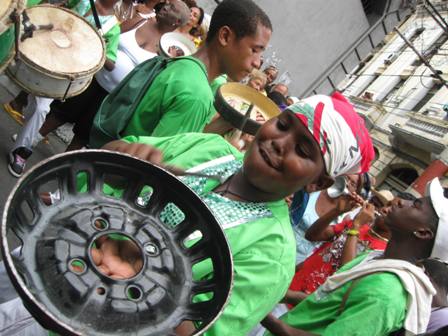The Fire Festival of Santiago de Cuba
Photo Feature by Janis Hernandez, text: Dariela Aquique

HAVANA TIMES, July 12 — There are many nicknames for Santiago de Cuba: “The Heroic City,” “The Cradle of the Revolution” and “The Balcony of the Caribbean,” to cite just a few. However the designation “The Hot Land” points to the distinguishing characteristic of this multifaceted city. In fact, there just occurred nothing less than “The Fire Festival,” the popular name given to the annual Festival of Caribbean-Origin Culture.
Every year, from July 3 to 9, the most anticipated festival is held by the city’s residents, second only to their famous carnival, which falls at the end of the same month. In the intense mid-summer heat, delegations from all countries of the Caribbean converge here. This year was the festival’s 31st edition and was dedicated to Trinidad and Tobago. There also arrive artists and friends from all corners of the planet tempted by the warmth of this fiesta and the charms of the city to participate in this festive spree.
The Fire Festival is kicked off every year with a majestic cultural gala in the Heredia Theater. Individual and collective visual arts exhibitions, theoretical events, workshops, seminars, colloquiums, theatrical and dance performances, jam sessions, trova music, literary get-togethers, etc. flood the whole city during the week. There is not a single cultural or social institution that is not involved in the festivities.

The “desfile de la serpiente” (the snake parade), with its journey that twists along the whole of Aguilera Street — from the ever popular Plaza de Martes to the well-frequented Parque de Cespedes — showcases all of the participating delegations, each hoisting their national flag and sharing their songs and dances with the people of Santiago.
During the week it was impressive to see the minister of Culture, Abel Prieto, receive a despojo (healing) from an Afro-Cuban babalawo priest or to find maestro concert pianist Frank Fernandez recite a prayer to Haitian singer and actress Martha Jean-Claude.
On July 9, thousands of people converged on Michelson Boulevard to witness the culminating activity of the Caribbean Festival: The burning of the Devil. This ceremony consists of the beating of drums while flammable materials are used to construct a giant effigy that symbolizes evil.
The wrongs that Caribbean peoples have suffered are said to be addressed with the lighting of the figure, which simultaneously signifies the liberation of good, happiness and festiveness. Women, children, men, the elderly, people of all types danced around the giant shouting euphoric screams that mixed with the sounds of the fireworks that indicated the end of the celebration.
History of the Festival

This festival was initiated in 1980 by the intellectual Joel James Figarola, who died in 2007, but who was also the founder and creator of the Casa de la Caribbean, an institution that sponsors a range of dissimilar events that have fostered ongoing research into the spirit of the Caribbean environment.
He was a versatile, controversial and polemical writer and researcher who left as his legacy a vast work on the national historiography that dealt with our African roots and the most traditional elements in our culture and religious practices.
Every year his relatives, friends, colleagues and people in general pay homage to this compelling Santiagoan who remains among us in the hills, the stepped streets, the conga lines, street theater, in magical religious rituals and in the unique burning of the Devil.
Click on the thumbnails below to view all the photos in this gallery. On your PC or laptop, you can use the directional arrows on the keyboard to move within the gallery. On cell phones use the keys on the screen.






























Comments are closed.